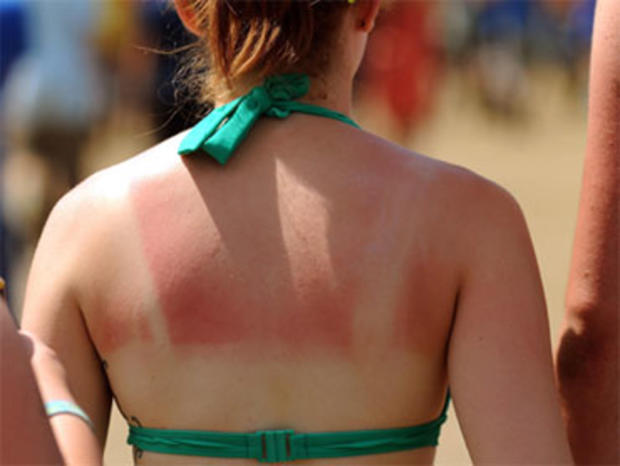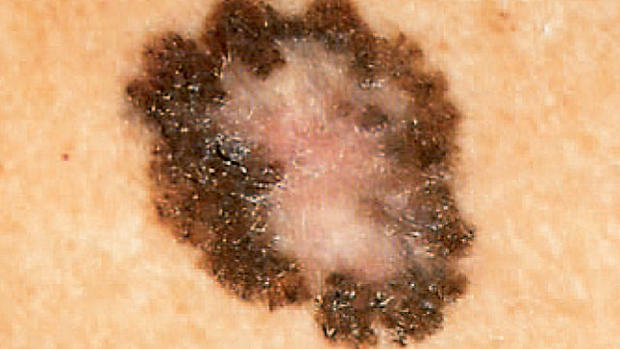CDC: Skin cancer risks for young adults on the rise, driven by sunburn and indoor tanning
(CBS/AP) Skin cancer risk is on the rise among young adults in the U.S., according to two new studies from the Centers for Disease Control and Prevention.
PICTURES: Is it skin cancer? 38 photos that could save your life
UV photographs may reveal potential for getting skin cancer
Indoor tanning tied to common skin cancer: Report
According to the CDC, half of U.S. adults under 30 say they have had sunburn at least once in the past year, and that suggests young people aren't heeding the warnings about skin cancer. The rate of sunburn is about the same as it was 10 years earlier, reversing progress reported just five years ago.
"I don't know that we're making any headway," said Dr. Len Lichtenfeld, the American Cancer Society's deputy chief medical officer.
Experts say that even one blistering burn can double the risk of developing melanoma, an often lethal form of skin cancer.
The Centers for Disease Control and Prevention released the studies Thursday, one of which was based on a 2010 survey of about 5,000 U.S. adults ages 18 to 29. The study found that the share of those who said they had had a sunburn in the preceding year went from about 51 percent in 2000 to 45 percent in 2005, but then went back up to 50 percent in 2010.
Researchers aren't sure why the sunburn rate picked up again, said Dr. Marcus Plescia, director of the CDC's Division of Cancer Prevention and Control.
Surprisingly, the CDC also found an increase since 2005 in how many people said they wear sunscreen or take other steps to protect their skin. But only about a third said they usually wore sunscreen - and the increasing rate of sunburns suggests many people are not putting on enough or re-applying it sufficiently, some experts said.
The second study the CDC released Thursday, showed how many people use tanning beds, booths or sun lamps, and Lichtenfeld said of the results: "I am astounded."
About 6 percent of all adults said they went indoor tanning in the previous year. The rates were significantly higher in young white women where about a-third of white women ages 18 to 21 had done indoor tanning, and nearly as many white women 22 to 25 did.
A similar survey in 2005 found about 27 percent of young women said they had done indoor tanning.
The latest study found indoor tanning often involved more than one trip to a salon for the novelty of it, or to bronze for a special occasion. Women in their 20s said they did indoor tanning more than 20 times in the previous year, on average.
Another surprise: As many as 13 percent of women who had a family history of skin cancer had done indoor tanning.
Experts said there is no longer significant scientific debate that indoor tanning causes cancer. In 2009, tanning devices were classified as carcinogenic by the World Health Organization. That was based on an analysis of 20 studies that found the risk of melanoma rose 75 percent in people who started indoor tanning before age 30.
"It's not a question of whether tanning beds cause cancer anymore. We've been able to prove that," said Dr. Jerry Brewer, a Mayo Clinic dermatologist and researcher.
Indoor tanning has been tied to an increased risk in deadly melanoma skin cancer, and a 2011 study found it also increases the risk for the most common type of skin cancer, basal cell carcinoma, HealthPopreported.
And there does seem to be more public understanding of the risk, as recently spotlighted by the public backlash over the case of a deeply bronzed New Jersey woman arrested for allegedly taking her 5-year-old daughter into a tanning booth. Police said the kindergartner suffered a burn while the mother denied taking her into the booth, CBS News reported.
Indoor tanning took off about 30 years ago. There are nearly 22,000 salons across the U.S., serving an estimated 28 million customers, according to IBISWorld, an industry research firm.
Melanoma rates have been increasing for at least three decades. About 76,000 cases will be diagnosed in U.S. adults this year, and about 9,200 people are expected to die of the disease, according to the cancer society.
The CDC's Plescia said tanning beds are driving "an epidemic in the making."
"More public health efforts, including providing shade and sunscreen in recreational settings, are needed to raise awareness of the importance of sun protection and sunburn prevention to reduce the burden of skin cancer," Plescia said in a CDC statement emailed to CBS News. "We must accelerate our efforts to educate young adults about the dangers of indoor tanning to prevent melanoma as this generation ages."
Others shared that concern.
"It's the sunburn you got when you were 18 that leads to the cancer you get when you're 40," warned Dr. Zoe Draelos, vice president of the American Academy of Dermatology. "That sunburn will come back to haunt you."

